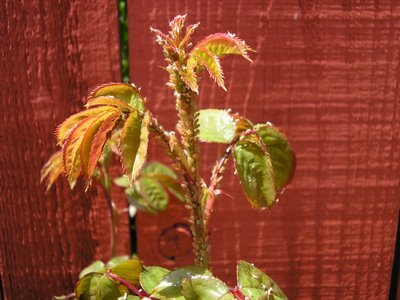
Aphids and some other little green thingies were feasting on my Elaine Gillet shrub rose. One lone ladybug was on the rose to do battle with them--hardly a fair fight. I blasted the aphids with the hose, but by the time I'd watered the rest of the yard and put the hose away, they were already beginning to regroup. I only have three roses--this one and two from my grandmother's house that are already struggling--so I can't afford to give one up to aphids. I'll try some other organic remedies first, but if it means bringing out the big, nasty chemical weapons, I guess I'm willing to do that. I really want these roses to do well.
And thank goodness, there are some flowers that aren't troublesome at all. The daffodils that I didn't get planted until mid-January are blooming in spite of my neglectful gardening. Three nameless ones and the first of a batch called Professor Einstein are both beautiful and carefree.



need the ladybirds to come and eat all those aphids.I grew french marigolds last year and this year i have seen about twenty ladybirds.goodbye mr Aphids sucking my roses.
ReplyDeleteSpraying them with water is suppossed to work.Keep at it Clare.I get very broody over my plants hence the slug pellets.Am working nights and i could not bear the thought of the slimeys eating my forget me nots and foxgloves.you make me smile with your posts!
Yeah, hang in there with the ladybugs and blasts of water. Lady beetles can be pretty voracious eaters according to Cornell...
ReplyDelete"Lady beetles are voracious feeders and may be numerous where prey are plentiful and broad-spectrum insecticide use is limited. Lady beetles need to eat many aphids per day so that they can lay eggs. The convergent lady beetle may eat its weight in aphids every day as a larva and consume as many as 50 aphids per day as an adult. Sevenspotted lady beetle adults may consume several hundred aphids per day and each larva eats 200 to 300 aphids as it grows. Once the adults and larvae have eliminated an aphid colony, they will search for additional food."
There are other excellent aphid predators and parasites that you'd need a magnifying glass to see. There's a tiny wasp that lays eggs IN your aphids. Its young emerge from a perfectly round hole. If you ever see aphids that are tan-colored, kind of puffed up and not moving, grab a magnifying glass and look for the tiny round hole from which the wasp emerged.
I would avoid the nasty chemicals so beneficials like this can do their job.
Good luck!